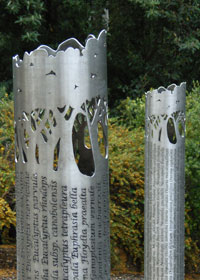 Public Art Program
Public Art Program
Sentinels
Sculptural bollards by Simon A C Taylor
About the Gardens ’ Public Art Program
The Gardens ’ Public Art Program was initiated in 2001 with the release of a Public Art Masterplan funded by the Friends of the Gardens.The Masterplan was prepared by Pamille Berg and describes the conceptual basis for art in the Gardens, some ‘starting points ’ for artist commissions and mechanisms to implement the program. An Art Advisory Committee (AAC) was established in early 2002 to oversee the implementation of the program.
In June 2002 a brief commissioning a set of sculptural bollards at key entrances to the Gardens was advertised nationally. Around 50 responses were received and three artists shortlisted to prepare concepts for the projects. A final selection was endorsed by the Gardens AAC in early 2003..
Other projects arising from the Gardens Public Art program include:an exhibition of furniture from Australian timbers designed and made by Niklavs Rubenis (February 2004); a chair-making workshop using 18th and 19 th century hand tools in collaboration with the Wood Workshop,Canberra School of Art (March 2004);and an artist-in-residence program in association with the Australian Network for Art and Technology (July-October 2004).
About the Commission
Simon Taylor brings a strong background in visual art, landscape architecture and horticulture to his sculptural work, Sentinels, at the Australian National Botanic Gardens. The result is an informed and responsive design that addresses the signifi cant role of the Gardens in the promotion and protection of Australian plants.

In the Artist ’s words:
Nine stainless steel bollards stand as sentinels at key entrances to the Australian National Botanic Gardens.The bollards collectively list over one thousand endangered, vulnerable and extinct native plant species.
The intention of these sculptures is to help broaden public understanding of both the Gardens and to capture a moment in time documenting the fragility of our native ecosystems. The sculptures encourage visitors to recognize the signifi cance of the Gardens and the importance of growing,studying and promoting Australian plants. In an age of information overload it is intended that the sentinels succinctly state essential knowledge about the state of our environment.
The project has taken over two years to complete and incorporates new adaptations of laser cutting technology. The plant names form silhouettes in the stainless steel pipes and are illuminated by light.The steel and light give a sense of permanence and of the ephemeral. The sentinels are a memorial to what we have lost,and remind us of what are in danger of losing and that which we can help to preserve.
About the Artist
Simon Taylor was born in 1964. He holds a Master Degree in Visual Arts and Bachelor of Landscape Architecture and a Diploma in Horticulture.
Completed projects by Simon Taylor Landart are represented throughout the Asia Pacific region in civic, urban and rural landscape settings. The emphasis of the studio is on landart – the convergence of traditional landscape architecture with the sculpture of land and space.Commissions have included parks and gardens,sculptures and installations, festivals and special events, and theatre and film sets.
Recent works include:
2003 ‘Wood for the Trees’ Melbourne, Australia
Private commission to in-situ fell, mill and build a landart sculpture from a declining 150 year old Cupressus
macrocarpa tree within an historic Melbourne garden.
2002 Paroa Bay, Bay of Islands, New Zealand
Extension of landscape design of a 10 acre native coastal landscape within a 300 acre native forest sanctuary.
2001 ‘Wicked Festival’ Gaswork Park, Albert Park, Melbourne Australia
Temporary half acre grass painting of clay and turf paint for art festival.
2000 ‘Eco, Arc & Ammo’ Williamstown, Melbourne,Australia
Six metre steel sculptures for three traffi c roundabouts signifying the landscape alteration from a wetland to a reclaimed rifl e range and housing development.
Sculpture commission for channel Nine ‘Halifax M.D.’ Episode 10 filmed at the Victorian Art Centre.
Recent Awards include:
2002 Heard Park, Auckland, New Zealand
Awarded design stage of the Parnell town square for Auckland City Council within 1 acre of bequeathed parkland on Parnell Rise.
2001 ‘Sensory Gardens’ Auckland Domain, New Zealand
Awarded concept design stage for 5 acre park by Auckland City council, NZ Royal Blind Foundation and Ngati Whatua Tribe.A series of sculptural landart spaces exploring time, smell, touch, taste, sound and place.
2000 Yarra Gateway Sculpture Commission, City of Manningham,Melbourne, Australia.
Shortlisted.
About Threatened Australian Plants
Australia is home to around 20,000 plant species,many of which are found nowhere else in the world.Since 1770, more than 60 species of Australian plants have become extinct, over 50 are critically endangered (facing an extremely high risk of extinction in the wild in the immediate future) and more than 1100 are under threat. The cause has been primarily due to the large-scale destruction of natural habitats by the clearing of land since European settlement for housing, agriculture and industry. For example,the estimated original extent of the Big Scrub (subtropical rainforest between Lismore and Bangalow in northern NSW) was over 75 000 hectares. However, by 1900,it had been reduced to around 300 hectares scattered over ten remnant areas.
The mission of the Australian National Botanic Gardens is to grow, study and promote Australian flora. As part of our dedication to protecting Australian plants, threatened species are cultivated and researched in the Gardens. This helps increase knowledge about how to support their regeneration in their natural habitats and maintains a small ‘captive’ population as a scientific resource.
The Gardens play a critical role in educating and informing the public about threatened Australian plants. Simon Taylor ’s Sentinels underscore the urgency and importance of our task.

![Director of National Parks [logo]](../../../../../images/dnp_90px.gif)





